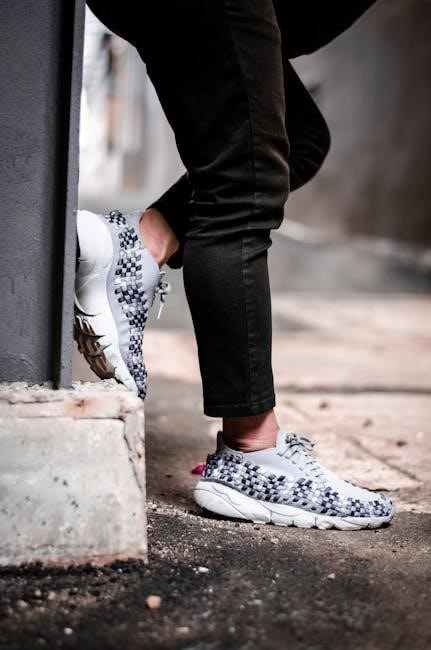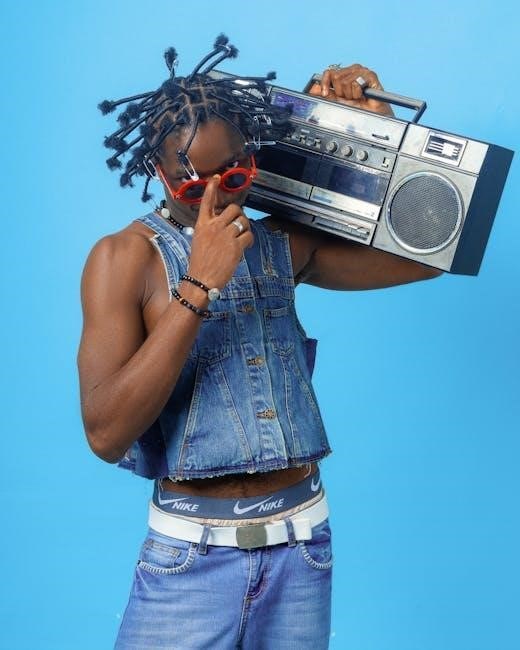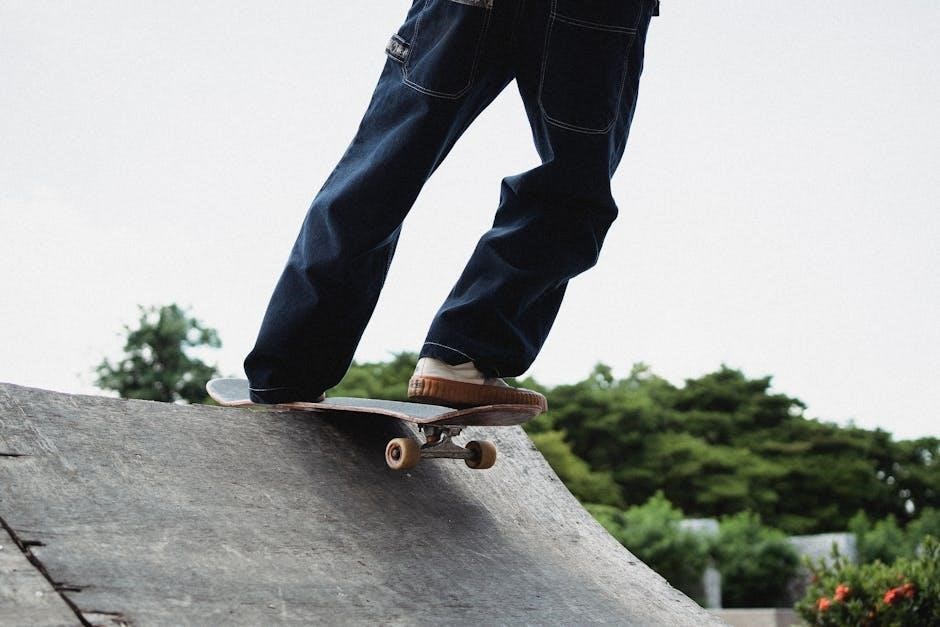A well-fitting pair of jeans can transform your wardrobe, balancing comfort and style. This guide explores how to find the perfect fit, catering to different body types and personal preferences.
Why Jeans Fit Matters
A well-fitting pair of jeans is essential for both comfort and confidence. Proper fit enhances your overall appearance, creating a balanced and polished look. Jeans that fit correctly avoid discomfort, such as tight thighs or waist gapping, ensuring all-day wearability; The right fit also complements your body type, whether you’re slim, muscular, or stocky. Additionally, good fit prevents excessive fabric that can look sloppy or unflattering. Learning how jeans should fit is a skill that can elevate your style, making it a worthwhile investment in your wardrobe. A perfect fit is the foundation of a great outfit, blending practicality with personal style.
Understanding Your Body Type
Recognizing your body type is crucial for selecting jeans that flatter your frame. Slim men have lean builds, while muscular men have broader chests and thighs. Stocky men carry more weight around the midsection and legs. Each body type requires a specific fit to balance proportions. Slim-fit jeans suit lean frames, while straight or relaxed fits accommodate muscular builds. Stocky men often benefit from relaxed or bootcut styles to create a balanced silhouette. Understanding your body type helps narrow down the ideal fit, ensuring comfort and a polished appearance. This knowledge is the first step in finding jeans that complement your physique perfectly.
Measuring for the Perfect Fit
Accurate measurements are essential for a flawless fit. Measure your waist, inseam, and thigh to determine your ideal size. Proper sizing ensures comfort and style alignment.
How to Measure Your Waist
To measure your waist for jeans, stand naturally and place a flexible tape measure around your natural waistline, typically just above your hipbones. Keep the tape snug but not tight, ensuring it’s parallel to the floor. Avoid inhaling deeply or slouching, as this can distort the measurement. For accurate results, measure without holding your stomach in. This measurement will help determine your ideal waist size when shopping for jeans. Compare it to size charts to find your best fit, ensuring comfort and style. Proper waist measurement is key to avoiding gapping or tightness in your jeans.
Understanding Inseam and Outseam
Inseam refers to the length of the jeans from the crotch seam to the bottom of the leg. Outseam measures from the waistband to the hem. These measurements determine how the jeans fit and break on your shoes. A longer inseam creates a fuller break, while a shorter one offers a cleaner look. Outseam influences the overall style, with shorter lengths suiting slimmer cuts and longer ones fitting relaxed or bootcut jeans. Accurate measurements ensure the perfect balance between style and comfort, helping you choose jeans that flatter your body type and personal aesthetic.
Types of Jeans Fits
Explore various jean fits like slim, straight, relaxed, and bootcut, each catering to different body types and personal styles for a tailored look and comfort.
Slim Fit Jeans
Slim fit jeans are tailored to hug the body closely, offering a modern, streamlined appearance. They are snug through the thigh and taper slightly from the knee down, creating a sleek silhouette. Ideal for men with lean or athletic builds, slim fit jeans accentuate a fitted physique without feeling restrictive. Pair them with slim-fit shirts for a cohesive look or layer with jackets for versatility. These jeans are perfect for casual outings or semi-formal events, blending comfort and style effortlessly. The tapered leg also complements sleek footwear, making them a versatile choice for various occasions. Opt for dark washes for a polished look or light washes for a relaxed vibe.
Straight Fit Jeans
Straight fit jeans offer a classic, timeless style with a consistent width from the thigh to the ankle. They are neither tapered nor relaxed, providing a balanced fit that suits most body types. These jeans are ideal for men seeking comfort and versatility, as they work well for both casual and semi-formal settings. The straight leg complements boots, sneakers, or dress shoes, making them a practical choice. They also accommodate muscular or stocky builds comfortably. Pair dark washes for a sleek look or opt for light washes for a relaxed, vintage vibe. Straight fit jeans are a wardrobe staple for their adaptability and enduring appeal.
Relaxed Fit Jeans
Relaxed fit jeans offer a roomier cut through the thigh and seat, providing exceptional comfort. They are ideal for men who prefer a looser fit without sacrificing style. These jeans are perfect for stocky or muscular builds, as they allow ample space in the legs. The relaxed fit works well for casual outings and everyday wear. Pair them with oversized shirts for a laid-back look or dress them up with a fitted jacket. With a medium to high rise, they offer versatility in styling. Relaxed fit jeans are a great choice for those prioritizing comfort while maintaining a relaxed, modern aesthetic.
Bootcut and Flare Jeans
Bootcut and flare jeans feature a wider leg opening, creating a balanced silhouette. Bootcut jeans have a subtle flare, while flare jeans widen more dramatically from the knee down. These styles are ideal for men with muscular or stocky builds, as they balance proportions. Bootcut jeans pair well with boots, while flare jeans can be dressed up or down. They offer a retro vibe and are versatile for casual or semi-formal looks. Pair with fitted tops to avoid bulkiness. These jeans are perfect for those seeking comfort and a stylish, timeless appeal, making them a great addition to any wardrobe. They suit various body types.

Jeans for Different Body Types
This guide helps determine the best jeans fits for slim, muscular, and stocky men. The right fit complements your body type, ensuring comfort and style.
Fit for Slim Men
Slim men look best in jeans that create a balanced silhouette without clinging too tightly. Slim-fit or straight-fit jeans are ideal, as they skim the body without being restrictive. These styles elongate the legs and maintain a clean, streamlined appearance. Avoid overly loose fits, as they can overwhelm a slimmer frame. Pair with fitted tops to enhance proportions and ensure a polished look. Opt for light to medium washes to add visual interest without bulk.
Fit for Muscular Men
Muscular men require jeans that offer both comfort and structure. Relaxed or athletic-fit jeans are ideal, as they provide room in the thighs while maintaining a tailored look. Look for jeans with a bit of stretch, such as those with elastane, to ensure mobility and a flattering fit. Avoid slim-fit styles, as they may feel restrictive. Opt for a mid-to-high rise to support the waist and create a balanced proportion. Dark washes can create a slimming effect, while lighter washes add versatility to casual outfits. Ensure the inseam aligns with your height for a polished finish.
Fit for Stocky Men
Stocky men should prioritize comfort and balance when choosing jeans. Relaxed or straight-fit styles are ideal, as they provide ample room in the thighs and knees without clinging to the legs. Avoid slim-fit jeans, as they may feel restrictive. Opt for dark washes, which create a slimming effect, and consider high-rise options to elongate the torso. Jeans with a bit of stretch, such as those containing elastane, offer added comfort and flexibility. Ensure the inseam aligns with your height to avoid excess fabric pooling at the ankles. This combination creates a flattering, balanced look for stocky men.
Understanding Jeans Rise
Jeans rise refers to the distance from the crotch to the waistband, influencing comfort and style. Low-rise offers a modern look, mid-rise provides balance, and high-rise creates a classic, tailored feel.
Low-Rise Jeans
Low-rise jeans sit below the natural waistline, typically 7-8 inches from the crotch, offering a modern, trendy look. They are ideal for slim or muscular body types, as they create a longer torso illusion. Low-rise styles often feature a shorter inseam, making them suitable for casual outfits. However, they may lack support for some body types and can cause discomfort due to the lower rise. Styling tips include pairing them with belts to define the waist or tucking shirts for a sleek appearance. While they are fashionable, comfort and practicality should guide your choice.
Mid-Rise Jeans
Mid-rise jeans offer a balanced fit, sitting 9-10 inches from the crotch, providing both comfort and style. They are versatile, suitable for most body types, and strike a middle ground between low-rise and high-rise styles. Mid-rise jeans are ideal for those seeking a classic look without sacrificing modern trends. They pair well with tucked shirts for a polished appearance or belts to define the waist. This style accommodates various builds, offering support and flexibility, making them a practical choice for everyday wear. Their moderate rise ensures they stay fashionable while maintaining comfort and versatility for different occasions.
High-Rise Jeans
High-rise jeans are a stylish and comfortable option, sitting approximately 11 inches from the crotch. They offer a retro vibe while providing excellent coverage and support. This style is ideal for men who prefer a more traditional fit or want to elongate their torso. High-rise jeans are particularly flattering on taller or larger builds, as they create a balanced silhouette. They can be dressed up or down, making them versatile for casual and semi-formal occasions. Pair them with tucked shirts for a polished look or layer with jackets for a modern aesthetic. High-rise jeans combine nostalgia with contemporary fashion, offering both comfort and style.
Inseam and Pant Length
Inseam measures the length from the crotch to the pant leg’s bottom, impacting fit and style. Proper pant length ensures jeans drape neatly, avoiding excessive bunching or dragging.
How Inseam Affects Fit
Inseam length significantly impacts how jeans fit and look. A longer inseam can cause fabric to bunch up around the ankles, while a shorter inseam may feel restrictive. Proper inseam ensures jeans drape smoothly from thigh to shoe, preventing excessive dragging or tightness. For full-length styles, the hem should graze the top of the shoe. Cropped jeans, meanwhile, should hit just above the ankle for a clean look. Balancing inseam with body proportions is key; longer inseams can elongate shorter legs, while shorter inseams suit petite frames. Correct inseam ensures comfort and a polished, tailored appearance. Always measure accurately for the best fit.
Cropped vs. Full-Length Jeans
Cropped jeans end above the ankle, offering a modern, stylish look, while full-length jeans extend to the shoe, providing a classic fit. Cropped styles are ideal for showcasing shoes or adding a trendy touch, pairing well with boots or sneakers. Full-length jeans create a streamlined appearance and are versatile for both casual and dressed-up outfits. The choice depends on personal style and body type; cropped jeans can elongate legs, while full-length offers a balanced look. Proper inseam ensures comfort and aesthetics, making it essential to measure accurately for the best fit. Both styles can enhance your wardrobe when chosen thoughtfully.

Fabric and Wash
Fabric and wash significantly impact jeans’ comfort, durability, and style. Denim types vary in weight and stretch, while washes range from light to dark, influencing versatility and aesthetics.
Denim Fabric Types
Denim fabric types vary in weight, stretch, and texture, impacting comfort and durability. Stretch denim offers flexibility, ideal for slim fits, while selvage denim is durable and timeless. Raw denim retains its natural texture, requiring minimal washes. Lightweight denim suits warm weather, and heavy denim is perfect for cooler climates. Each fabric type caters to different lifestyles and preferences, ensuring a balance between style and practicality. Understanding fabric differences helps in selecting jeans that align with your needs and desired aesthetic.
Light Wash vs. Dark Wash Jeans
Light wash jeans offer a casual, vintage look, while dark wash jeans provide a sleek, polished appearance. Light washes are ideal for summer or relaxed outfits, creating a laid-back vibe. Dark washes, however, are versatile and can easily be dressed up or down, making them suitable for both casual and formal settings.
Choosing between the two often depends on personal style and occasion. Light washes can make legs appear longer, while dark washes create a slimming effect. Both options are timeless, ensuring a wardrobe staple that complements various looks and body types effectively.

Common Fit Issues and Solutions
Common fit issues include waist gapping and tight thighs. Solutions involve proper measurements, belt use, and choosing styles that suit your body type.
Solving Waist Gapping
Waist gapping occurs when jeans sit too loosely around the midsection, creating an unflattering gap. To address this, ensure your waist measurement is accurate and consider a belt for support. Opting for mid-rise or high-rise jeans can provide better coverage and a more secure fit. Additionally, stretch denim can offer flexibility and hug your waistline more closely. If the issue persists, tailoring your jeans to your measurements can create a customized fit. Proper sizing and style selection are key to eliminating waist gapping and achieving a comfortable, polished look.
Fixing Tight Thighs
Tight thighs in jeans can be uncomfortable and unflattering. To address this, ensure you’re wearing the correct size and consider a style with a slightly roomier fit through the leg, such as straight or relaxed-fit jeans. If you prefer slim-fit styles, opt for stretch denim, which offers flexibility without sacrificing shape. Avoid sizing down excessively, as this can lead to restricted movement. Tailoring is also an option—small adjustments can create a more comfortable fit while maintaining the overall look. Prioritize comfort and mobility to strike the right balance between style and practicality.
Styling Your Jeans
Jeans are versatile and can be styled for any occasion. Pair them with a crisp shirt for a polished look or with a casual tee for a relaxed vibe.
Casual Outfit Ideas
For a laid-back look, pair your well-fitting jeans with a classic white T-shirt and sneakers. Add a denim jacket for a timeless vibe or a graphic tee for personality. Layering a flannel shirt over a plain tee creates a cozy, effortless style. Opt for a bomber jacket and boots for a slightly edgy feel. Accessories like a leather belt or a minimalist watch can elevate your casual outfit. Experiment with light or dark wash jeans to match your mood. Remember, the key to a great casual look is comfort and confidence, so choose pieces that reflect your personal style.
Dressing Up Your Jeans
Elevate your jeans for a polished look by pairing them with a button-down shirt, blazer, or leather jacket. Swap sneakers for loafers or dress boots to instantly refine your style. A fitted dress shirt tucked into slim-fit jeans creates a sleek, modern appearance. Add a tie or pocket square for a touch of sophistication. Dark wash jeans work best for dressing up, as they mimic the look of formal trousers. Accessories like a quality belt and minimalist watch can enhance the overall elegance. Layering a cardigan or bomber jacket over a crisp shirt adds depth to your outfit, making jeans versatile for smart-casual events.
Caring for Your Jeans
Wash jeans inside out in cold water to preserve color and prevent fading. Avoid using dryers; air-dry to maintain shape and fabric integrity. Store neatly to keep them looking sharp and fitting well.
Washing and Drying Tips
To maintain the quality and fit of your jeans, wash them inside out in cold water to prevent fading and shrinking. Avoid using bleach or harsh detergents, as they can damage the fabric. For drying, skip the dryer to prevent shrinkage and wear; instead, air-dry your jeans by laying them flat or hanging them. This preserves the denim’s integrity and maintains their shape. Spot clean stains before washing to avoid unnecessary wear. Turn jeans inside out during washing to protect the outer fabric from friction. By following these care tips, your jeans will remain comfortable, stylish, and well-fitting for years to come.
Online Shopping Guide
Use filters like waist size, inseam, and fit type to narrow your search. Read reviews for sizing feedback and check the size chart for accuracy. Virtual fitting tools can help ensure the perfect fit without trying them on. Compare different styles and brands to find your ideal pair. Look for high-quality images and detailed descriptions to make informed decisions. Prioritize customer reviews and ratings to gauge comfort and durability.
How to Search for the Right Pair
When searching for the perfect jeans, use specific keywords like “slim fit,” “straight leg,” or “high-waisted” to narrow results. Filter options by waist size, inseam, and fabric type to refine your search. Check size charts for accurate measurements and read customer reviews for sizing feedback. Utilize virtual try-on tools if available to visualize the fit. Compare different brands and styles to find the best match for your body type and preferences. Look for detailed product descriptions and high-quality images to assess features like pockets, stitching, and wash. Prioritize reviews mentioning comfort, durability, and true-to-size fit to make informed decisions.
Budget Considerations
Affordable jeans offer great value without compromising on essential features, while premium brands provide superior quality and durability. Consider budgets and needs, investing in timeless pieces that fit well, and look for sales or discounts to own premium styles without the high cost.
Affordable vs. Premium Brands
When choosing between affordable and premium jeans, consider your budget, lifestyle, and preferences. Affordable brands offer great value, providing essential features like a good fit and durability at lower prices. They are ideal for casual, everyday wear and often mimic trendy styles without the hefty cost. Premium brands, on the other hand, invest in high-quality materials, craftsmanship, and attention to detail, offering superior comfort and longevity. While more expensive, they can be seen as a long-term investment. Both options can deliver a great fit, so it’s important to weigh your priorities and what you’re willing to spend for the benefits you desire.

Accessories to Enhance Your Look
Accessories like belts and shoes can elevate your jeans outfit. A good belt defines the waist, while shoes add personality—sneakers for casual, boots for rugged, or loafers for dressy. Ensure your belt complements your shoes for a polished finish.
Belts and Shoes for Jeans
Belts and shoes are essential for completing your jean outfit. Choose a belt that complements your shoe color to create a cohesive look. Sneakers pair perfectly with slim-fit jeans for a casual vibe, while boots work well with straight or relaxed fits for a rugged style. Loafers or dress shoes can elevate jeans for a smarter appearance. Ensure your shoes are proportional to your jean leg opening for balance. Don’t forget socks—patterned or colored ones can add personality to your look. These accessories not only enhance style but also ensure your jeans fit seamlessly into any occasion.
Size and Fit Comparison Guide
Understanding size and fit variations is crucial for finding the perfect jeans. Different brands may have slightly different measurements, so comparing sizes across labels is essential. Start by knowing your waist and inseam measurements. Use size charts to align your measurements with the brand’s sizing. Consider your body type—slim, muscular, or stocky—to choose the most flattering fit. Try on jeans if possible, as fabric stretch and cut can vary. Online tools and reviews can also help you compare fits. Remember, the best fit combines comfort and style, so don’t hesitate to explore options until you find your ideal pair.
Current Trends in Men’s Jeans
Current trends in men’s jeans emphasize comfort, versatility, and timeless style. Slim and skinny fits remain popular, while straight and relaxed cuts are gaining traction for a more laid-back look. Sustainable denim is a growing focus, with brands incorporating eco-friendly materials. Higher rises, unique washes, and subtle distressing are also trending. Functional details like cargo pockets and stretch fabrics are increasingly sought after for practicality. These trends cater to diverse preferences, ensuring there’s a style for every man. Whether you prefer classic or modern designs, today’s jeans blend fashion and comfort seamlessly.

Real-Life Fit Examples
For slim men, slim-fit jeans create a streamlined look, while straight-fit jeans offer a balanced silhouette. Muscular builds thrive in straight or relaxed fits, accommodating broader thighs. Stocky men find comfort in relaxed or bootcut styles, which balance proportions. High-rise jeans flatter taller men, elongating their legs, while mid-rise suits shorter frames. Cropped jeans highlight stylish shoes, ideal for fashion-forward outfits. These real-life examples illustrate how different fits enhance various body types, ensuring a flattering and comfortable look for every man.
Mastering the art of men’s jeans fit is a journey that combines understanding your body type, measuring accurately, and exploring various styles. From slim to relaxed fits, the right pair enhances confidence and comfort; Key elements like waist, inseam, fabric, and rise ensure a personalized fit. By addressing common issues and styling wisely, you can elevate your look effortlessly. Whether dressing up or keeping it casual, a well-fitting pair of jeans is a wardrobe staple. Invest time in finding your perfect match, and experience the transformative power of denim tailored to you.
